Now Get Out of That

Synopsis
We can either do this the easy way or the hard way. Either you just take our word for it that this is one of the classic adventure game shows of all time, or we have to write pages of text explaining all the intricacies behind our belief. I see - it's going to be like that is it? Okay, here goes then.
The idea of NGOOT is that two teams of active and brainy people follow an adventure course over approximately 72 hours. There were four series made - the first two were Cambridge v Oxford battles, the last two US v UK tussles. Each series followed a vaguely espionage-induced plot, in that the teams were being sent on a special mission such as rescuing a defecting spy.
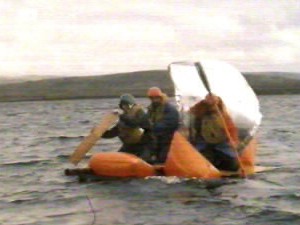 One team rows across a lake using their home-made raft
One team rows across a lake using their home-made raftAlong their course, they were a series of mental and physical challenges that had to be overcome before they could proceed. These could vary from creating a simple machine to opening a strong wooden box covered in 1000 screws to moving a huge boulder. Often the solutions to the problem were much simpler than they appeared, but that didn't stop the teams making a right pig's ear of them on regular occasions.
There were two key things that made this show so successful. One was the presence of journalist and writer Bernard Falk who gives us accurate character portraits of how the team are working along the way.
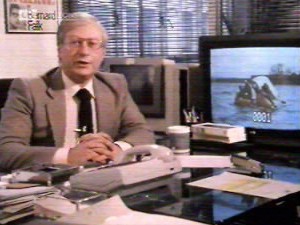 Voice-over man, Bernard Falk
Voice-over man, Bernard FalkHe also chipped in with brilliantly timed quips (added from the warmth and safety of an audio studio) to overlay the action. For example, when one team were descending from a high window using a rope made from sheets, the dialogue went:
American: Hey, it's just like Cinderella!
Falk: Or Rapunzel, if you like.
The other entertainment factor came from the extremely sneaky black humour that underlied many of the challenges. In one series, the team were given a map in jigsaw form, a new piece being given after each major stage. Of course, just as soon as the map was complete it was completely useless as they were at the end of their course. In other episode, the team were given four bicycles - but with only seven wheels between them. Further on the course they found the eighth wheel - but had they brought the fourth bike frame with them all that way? What do you think?
In one very sneaky challenge, the team had to retrieve the keys of a Land Rover (which were in a milk churn buried in the mud) without walking past a white line. Transgressing the rules meant that a gunshot would be fired, signalling a significant time penalty. The solution was that although the team couldn't walk, they could lie on the ground, crawl, even run.
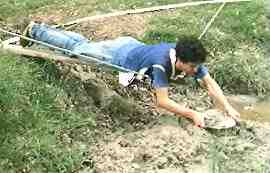 Well, that's one way of not walking on the ground...
Well, that's one way of not walking on the ground...Another example concerned the final episode of one series, when the team had to raid a castle which was "full of guards". They were told not to set off the booby trap, otherwise they would set of an alarm. Of course, there were absolutely no guards whatsoever. But that didn't stop the teams running scared, did it? How we laughed.
The final show of series 4 saw the teams break into a castle compound. Throughout the series the team had been given the words FLOWER, GLASSES and SHINE that they had been told to remember. When they arrived at the final location, they found two men in a prison cell who had been drugged. One was called NIGHT, the other called DAY. Obviously, one man had been put in the cells as a stool pigeon. The idea was that all the words they had been given all matched with SUN (sunflower, sunglasses, sunshine) and so sunDAY was the right man to choose.
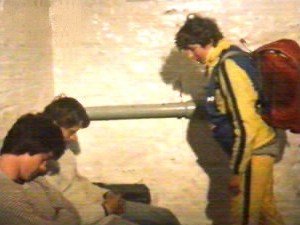 One contestant tries to suss out the difference between Mr Night and Mr Day
One contestant tries to suss out the difference between Mr Night and Mr DayAnd then there were still surprises at the end - such as when the scientist they were rescuing suddenly fell off the wall of the castle and "broke their ankle", so the team had to whisk up a stretcher as quickly as possible using some equipment handily placed nearby.
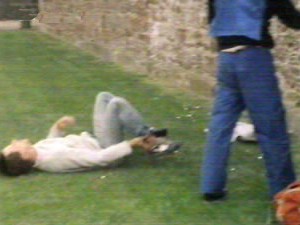 Oh, that's torn it...
Oh, that's torn it...NGOOT must have been done on a near shoestring budget, and its ideas were hampered by the technology available at the time. At the start of the course in series 4, a long and complicated set up saw the contestants taken up in gliders and light aircraft with parachutes on their back, expecting that they would have to jump for it. In fact they didn't have to do such a thing - it was just a joke to shake the contestants up a bit. However, it was a shame that minicams weren't around at the time to record the contestants reactions when they were told not to jump while mid-flight.
With only four or five episodes in each series, it hardly outstayed its welcome but neither did it have enough momentum to register in the conciousness of many fans. The final series was by far the most action packed in terms of flying, abseiling, amphibious vehicles and so on, but was lacking the ingenuity, multi-layered nature and sheer gall of the early tasks. Although looking at the repeats today makes this show look sooooo slooooow, with only two or three tasks filling each 30-minute episode, it still remains an inventive show that hasn't really been trumped by a more modern incarnation.
Key moments
When the contestants transgressed the rules, a gun shot would fire and they'd be penalised 5 minutes.
Any time the equipment provided their old favourites, the house brick and the milk bottle.
Theme music
There wasn't actually any theme music - it was just the title sequence with various sound effects over the top.
Series detail
1981 - endurance test around Eastnor Castle, Herefordshire.
1982 - teams compete to recover a top secret isotope from a crashed space craft.
1983 - teams had to destroy a simulated communications cable.
1984 - teams had to rescue a defecting bio-chemist from enemy territory.
Trivia
Although both teams followed the same course, they did so at different times. The action was cut back and forth between the two sides, with time checks given by Bernard so that we could keep track of who was winning.
One of the Oxford team in the second series was future travel-writer, TV presenter and Where's Wally lookalike, Nicholas Crane.
The first series went out as a stripped show, shown at the same time over consecutive days.
Web links
Opening titles from 1981 and 1984 in the BBC Motion Graphics Archive
Pictures
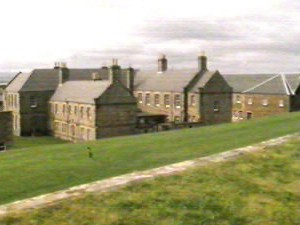 The team's final destination in one series. In real life, it's a Scottish country house.
The team's final destination in one series. In real life, it's a Scottish country house.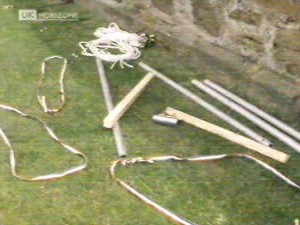 Some handily placed equipment
Some handily placed equipment
